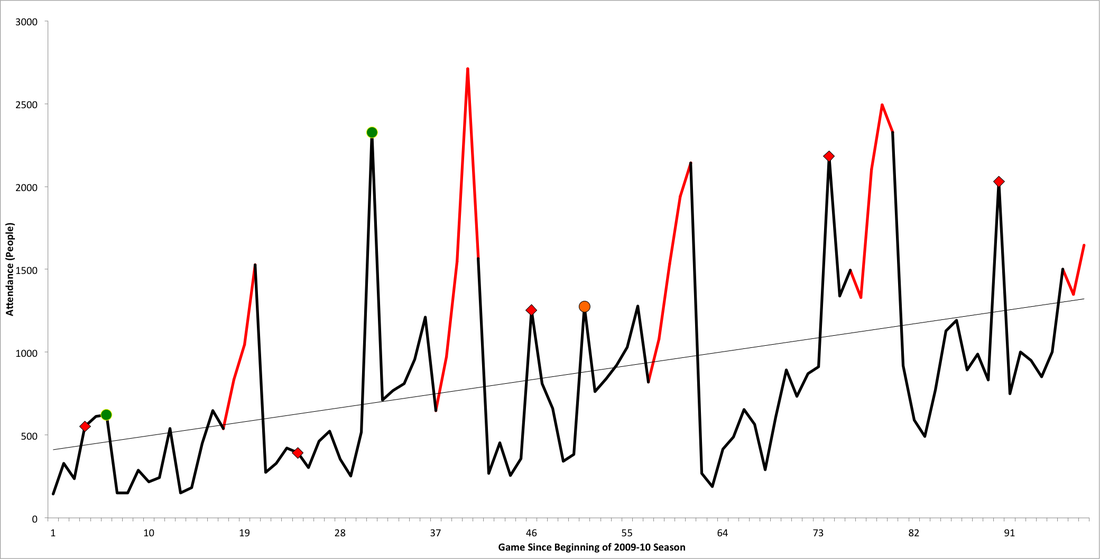The most common team to hold the first-place position over that five-season span? Mark Johnson's Wisconsin Badgers enjoy that distinct honor. The wearers of the W have drawn an average of 2,365 people to their games over the last five seasons. The Lynah Faithful need to take note. Cornell should not abide lingering behind the Badgers. Beat the Badgers should become a rallying call to draw greater crowds from hockey-obsessed East Hill and Upstate New York.
Nevertheless, one other easily recognizable truth emerges from general attendance data. For four years of the last half-decade, Cornell has remained unassailable as the greatest draw in Eastern women's college hockey. Desiring a more nuanced analysis, this writer tabulated the attendance data for all Cornell home games between the beginning of the 2009-10 season through the close of the 2013-14 season. The results follow.
Somewhat predictably, the red diamond data points indicate the occurrence of The Game at Lynah Rink each season. For seasons in which the Harvard was not the best-attended regular-season contest, another data point of the colors of the opponent Cornell hosted in that contest is provided. Those include games against Clarkson during the 2009-10 and 2010-11 seasons, and the home game against Princeton in the 2011-12 season.
Interestingly, Clarkson, not Harvard, was the opponent for Cornell's best-attended regular-season contest at home. That contest between eventual national champion-winning program Clarkson and perennial national contender Cornell drew 2,326 members of the Lynah Faithful to college hockey's greatest barn. Two goals from Catherine White, one marker from Brianne Jenner, and a shutout from Amanda Mazzotta ensured the largest crowd in Cornell's regular-season history enjoyed the affair.
The second graph merely appends a crude mean trendline to indicate what many already know: attendance at Cornell women's hockey games is increasing steadily from the program's modern rise during the 2009-10 season. What both graphs, perhaps more apparently in the first, illustrate is that attendance generally increases when the playoffs arrive on East Hill. Only in the 2013-14 season did one game surpass the attendance peak reached during the playoffs. Even the 2010-11 regular-season game against Clarkson was dwarfed by the crowd that assembled to witness Cornell's successful defense of its first ECAC Championship. 2,711 attendants watched as Mazzotta delivered another shutout and the Lynah Faithful set its still standing attendance record.
This inspired the graphical opening and analysis of this entire endeavor. Rarely is it written which programs draw the best for the playoffs. The preceding data indicate that Cornell is a program with a clear penchants for supporting the playoffs. This writer decided to tabulate the attendance at each playoff game over the last five season for the nation's premier and oft-praised women's hockey programs. The findings may be somewhat unsettling for boosters of certain corners.
For the cases of this analysis, home playoff games were defined not merely by location, but by a two-part examination. Firstly, the game must have been played at the program's primary home venue or an on-campus home venue used by the university's other hockey programs. Secondly, the right to play that game at home, in front of favorable fans, must have been earned on the ice rather than designated.
The second prong ensures that programs that happen to appear at events like the Frozen Four in their home arenas do not benefit from an unrepresentative increase in attendance from non-partisan fans who attend for the mere spectacle of such high-profile games. The purpose is to measure the zeal of a program's fans during the playoffs, not the ability of its athletic department to market a marquee event effectively.
The programs included were Boston University, Clarkson, Cornell, Harvard, Mercyhurst, Minnesota, Minnesota-Duluth, North Dakota, and Wisconsin. The programs that draw the best are unsurprising. The East and West each have two representatives in the top four. What may be shocking to some unfamiliar with the goings-on on East Hill is the order in which the top four fall. Minnesota and Wisconsin both trail behind Cornell in terms of average playoff attendance over the last five seasons.
Minnesota finishes third behind the Big Red and the Badgers. The gap is not enormous, but over 10% more people on average attend playoff games at Lynah Rink than they do at Ridder Arena. Cornell University with an enrollment of 21,000 students in a city of 30,000 inhabitants outdraws its nearest attendance rivals with university bodies ranging from 43,000 to 52,000 students in cities of 250,000 to 600,000 residents. The near-religious fervor of the Lynah Faithful is obvious.
The Lynah Faithful draw the most consistent playoff crowds of the top three as well. Minnesota and Wisconsin experience far wider fluctuations in their playoff attendances, manifested in large standard deviations, while the Lynah Faithful are dedicated and constants. Both characteristics prove the propriety of the descriptor "faithful."
It is true that Minnesota and Wisconsin typically outdraw Cornell in average attendance over the course of the season. However, no program has a more dedicated, consistent, and fearsome fanbase when the playoffs arrive than does Cornell hockey. The Lynah Faithful pack their sanctuary to cheer on the Lady Rouge like no other fanbase in college hockey can.
The playoffs are the institutionalized focus of Cornell hockey. They are the time when trophies are hoisted and banners raised. It is for what the Lynah Faithful wait months and, sometimes, years. In a distinctly Cornellian way, Cornell hockey is the best program in women's hockey, saving its most ardent, uplifting, and impassioned moments for the time when they matter the most.






 RSS Feed
RSS Feed
